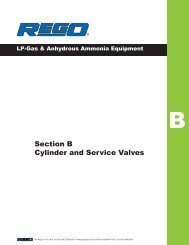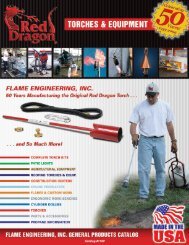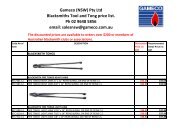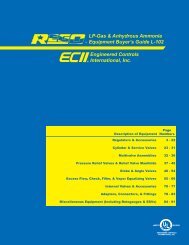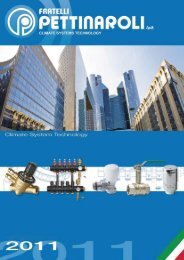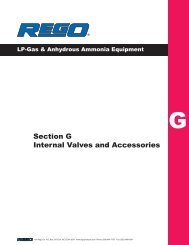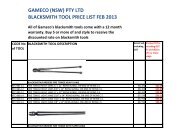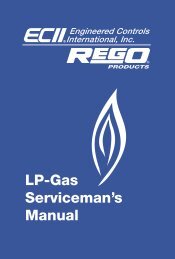Repair Kits Available By Part Number Section 2 Page - GAMECO
Repair Kits Available By Part Number Section 2 Page - GAMECO
Repair Kits Available By Part Number Section 2 Page - GAMECO
Create successful ePaper yourself
Turn your PDF publications into a flip-book with our unique Google optimized e-Paper software.
WARNING: Installation, usage and maintenance of this product<br />
must be in compliance with all Engineered Controls International,<br />
Inc. instructions as well as requirements and provisions of NFPA<br />
#54, NFPA #58, DOT, ANSI, all applicable federal, state, provincial<br />
and local standards, codes, regulations and laws.<br />
Inspection and maintenance on a periodic basis is essential.<br />
Installation and maintenance should be performed only by<br />
qualified personnel.<br />
Be sure all instructions are read and understood before installation,<br />
operation and maintenance. These instructions must be<br />
passed along to the end user of the product.<br />
CAUTION: Contact or inhalation of liquid propane, ammonia and<br />
their vapors can cause serious injury or death! NH3 and LP-Gas<br />
must be released outdoors in air currents that will insure dispersion<br />
to prevent exposure to people and livestock. LP-Gas must be<br />
kept far enough from any open flame or other source of ignition to<br />
prevent fire or explosion! LP-Gas is heavier than air and will not<br />
disperse or evaporate rapidly if released in still air.<br />
Installation<br />
The 8542 Series is designed especially for use as a primary relief device<br />
on smaller stationary storage containers up to 1200 gallons water<br />
capacity with 2" NPT threaded couplings. These manifolds allow<br />
servicing or replacement of either of the two relief valves without<br />
evacuating the container or loss of service. The operating lever<br />
selectively closes off the entrance port to the relief valve being removed<br />
while the remaining valve provides protection for the container and its<br />
contents. The rating of each manifold is based on actual flow through<br />
the manifold and a single pressure relief valve, taking friction loss into<br />
account. It is not merely the rating of the relief valve alone.<br />
If the DuoPort Manifold is to be used with a vent stack, the following<br />
installation procedures should be observed:<br />
1. Be certain that an ECII ® 3135-10 pipe-away adapter is threaded<br />
into the outlet of each safety relief valve. In addition to providing a<br />
2" NPT female connection for the installation of 2" pipe, this adapter<br />
has an externally machined weakness groove to facilitate breakage<br />
at this point, leaving the valve itself fully operative in case undue<br />
stresses are applied to the vent piping.<br />
2. Limit the height of the vent stack to a minimum. Be sure to include<br />
the approximate overall height of the DuoPort (11 9 /16") in<br />
determining the overall height of the vent required above the top of<br />
the container.<br />
3. Secure the two vent stacks firmly to each other midway or at the top<br />
to break the wind velocity between the stacks and to reduce the<br />
tendency to vibrate or oscillate. This may be accomplished by<br />
inserting a wooden block between the stacks and clamping them<br />
together at this point.<br />
Figure 1: Duoport ® Pressure Relief Valve Manifold<br />
8542 Series DuoPort ®<br />
Safety Relief Valve Manifold<br />
Installation, Operation and Service<br />
Instructions<br />
Operation<br />
In normal operation, the handle is kept at the center stop. In this<br />
position, both relief valves are open to the container vapor space. This<br />
provides extra relief capacity by permitting both valves to function<br />
simultaneously if necessary.<br />
To remove a safety relief valve for retesting or replacement:<br />
1. Pull out the locking latch to release the handle. See Figure 1.<br />
2. Rotate the handle upward to position beneath the valve to be<br />
removed. See Figures 1 and 3.<br />
3. Release the locking latch when the handle clears the ledge marking<br />
the off position. The spring loaded latch automatically retains the<br />
handle in this position.<br />
Figure 2: Bleeder Valve Detail<br />
Bleeder Valve in back-seated<br />
position – normal operating<br />
position. Permits equalization<br />
of pressure on both sides of<br />
shut-off disc after relief valve<br />
has been reinstalled.<br />
Bleeder Valve in the closed<br />
position. Permits pressure<br />
trapped between relief valve<br />
and shut-off disc to be bled off<br />
so relief valve can be removed.<br />
Figure 3: Side view without relief valves<br />
Shut-Off Position<br />
for Relief Valve<br />
Removal<br />
Safety Relief Valves<br />
For ordering information<br />
and pressure settings<br />
see the RegO ® L-500<br />
Catalog, call Engineered<br />
Controls International<br />
Inc., or call your local<br />
authorized distributor.<br />
Seal Ring<br />
Clapper in Shut-Off Position<br />
– for Relief Valve removal<br />
Handle in Shut-Off<br />
Position – for Relief<br />
Valve removal<br />
Rubber<br />
Stopper<br />
Locking Latch<br />
Bleeder Valve<br />
Shut-Off Position<br />
for Relief Valve Removal<br />
Center Stop Position<br />
for Normal Operation<br />
Clapper<br />
in Center Stop<br />
Position – for<br />
normal operation<br />
Handle in Center Stop<br />
Position – for normal<br />
operation<br />
Center Stop



